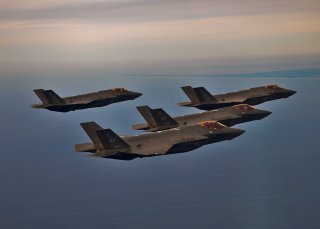NATO F-35 Stealth Fighters Can ‘Talk’ to One Another While Fighting
Should an attack come from a major rival such as Russia or China, F-35-armed U.S. allies like Japan, Israel, Australia, and throughout Europe would respond.
Here's What You Need to Remember: The Pentagon and NATO are also working to move beyond this and leverage the F-35s drone-like ISR components with increased connectivity to drones and other high-value aircraft such as F-22s and B-2s, among others. The Air Force has recently had some success in architecting radio systems and data links such as LINK 16 to enable two-way exchanges between F-35s and F-22.
Should the United States suddenly face a substantial and damaging military attack, the military would of course need to respond quickly, firing ship and submarine-launched Tomahawks into the attacking country. The military would also draw upon the existing Rapid Raptor program wherein F-22s are scrambled to strike anywhere in the globe within twenty-four to forty-eight hours. Finally, the Pentagon would send carrier strike groups to the necessary forward locations and deploying F-35s immediately.
The United States now operates a healthy and growing fleet of F-35s, and Air Force planners say more are regularly being sent for forward basing and deployments in Europe. However, what about the North Atlantic Treaty Organization (NATO), the Pacific and the growing international F-35 alliance? Should an attack come from a major rival such as Russia or China, F-35-armed U.S. allies like Japan, Israel, Australia and throughout Europe would respond. NATO might be of great significance, should some attack require a rapid response from the European continent.
The Australian Royal Air Force has recently announced that the first of its fleet of thirty-three F-35s are now operational, some of great significance given the importance of U.S. allied operations in the Pacific. Also, NATO ally Denmark is now armed with its first of twenty-seven planned F-35s. The first Danish F-35A has just rolled off the production line at Lockheed’s facility in Fort Worth, Texas, marking a sizable step forward for European and NATO F-35 partners.
This is significant in several pertinent respects. Should the United States be attacked from any enemy at any time, it could immediately trigger Article 5 which stipulates NATO collective security, an agreement based upon the premise that an attack against one constitutes an attack against all, immediately introducing the prospect of a massive, coordinated multilateral military response.
Therefore, having Denmark-based F-35s stationed in Northern Europe massively improves any kind of military response capability, should NATO need to spring into action. Given that Denmark borders the Baltic Sea, F-35s could quickly reach Eastern Europe should there be a need or some kind of contingency.
The largest advantage, however, may be that the addition of Denmark F-35s adds to the networking and NATO interoperability possibilities for data sharing and mission coordination. F-35s will also be in Norway, Italy and the United Kingdom, offering additional opportunities for an interconnected multi-national force of F-35 stealth fighters. F-35s from all participating nations are networked to one another through a common data link called MADL, Multifunction Advanced Data Link. MADL allows F-35s to quickly transmit a common operating picture, and share voice, video, data, navigational specifics and even targeting specifics across the fleet.
The Pentagon and NATO are also working to move beyond this and leverage the F-35s drone-like ISR components with increased connectivity to drones and other high-value aircraft such as F-22s and B-2s, among others. The Air Force has recently had some success in architecting radio systems and data links such as LINK 16 to enable two-way exchanges between F-35s and F-22. Moreover, there is a vigorous effort under way to further establish and refine technical standards such that all NATO aircraft, and even ground combat nodes, can operate as “nodes” within a dispersed, interconnected “kill web” of shared information.
In total, Lockheed has built 610 F-35s to support a growing international partnership of F-35 operators, to include eight nations and six foreign military sales customers.
Kris Osborn is the defense editor for the National Interest. Osborn previously served at the Pentagon as a Highly Qualified Expert with the Office of the Assistant Secretary of the Army—Acquisition, Logistics & Technology. Osborn has also worked as an anchor and on-air military specialist at national TV networks. He has appeared as a guest military expert on Fox News, MSNBC, The Military Channel, and The History Channel. He also has a Masters Degree in Comparative Literature from Columbia University. This article first appeared earlier this year.
Image: Flickr.

